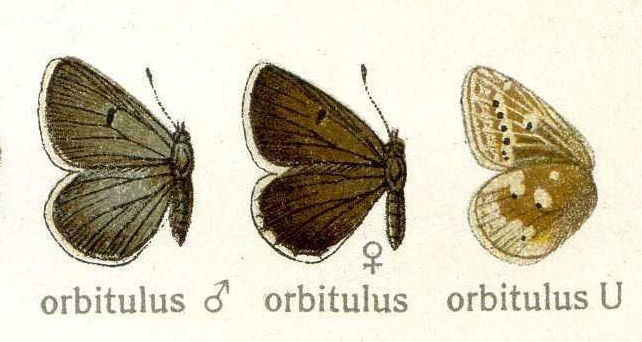- Lycaena orbitulus
Taxobox
name = Greenish Mountain Blue

image_caption = "Lycaena orbitulus" Male on left, female middle,underside right.
regnum =Animal ia
phylum =Arthropod a
classis =Insect a
ordo =Lepidoptera
familia =Lycaenidae
subfamilia =Polyommatinae
genus = "Lycaena "
species = "L. orbitulus"
binomial = "Lycaena orbitulus"
binomial_authority = (Esper ,1800 )The Greenish Mountain Blue ("Lycaena orbitulus") is a
butterfly in the familyLycaenidae . It is found inAsia andEurope .Description
:"See glossary for terms used"Race "jaloka" found in India was earlier called "Polyommatus jaloka" Moore, 1874. There is considerable variation in the species.
The male has the upperside brown with metallic green or blue to varying extents from the base outwards. The blue or green usually occupies the basal three-fourths of the wing. Towards the costa there is a broad edge and even broader along the termen of the ground colour. On the hind wing the blue or green occupies a medial area from the base to the disc, and leaves a broad brown edging to the costa, termen and dorsum. Fore and hind wings have discocellular black spots encircled by pale edgings, followed on both wings by transverse discal series of pale bluish-white spots and anticiliary slender black lines. In some these spots are very prominent, in others barely indicated. On the underside the wings are brownish, turning to greyish white on the termen. Fore wing underside has a more or less obscure pale-bordered discocellular spot, followed by a transverse, slightly curved discal series of six black spots encircled with white. The underside of the hind wing has the brown basal area irrorated inwardly with metallic blue scales and sharply demarcated from the greyish-white terminal area which occupies about half the wing; discocellular spot large and prominently white, as is an angulated transverse discal series of large spots; these latter spots in many specimens somewhat obscure on the greyish-white ground-colour of the terminal half of the wing. Cilia of both fore and hind wings conspicuously white. Antennae, head, thorax and abdomen brown ; the shafts of the antennae obscurely ringed with white, the thorax and abdomen with a little bluish pubescence in fresh specimens ; beneath : the palpi, thorax and abdomen white.
Female has the upperside brown, without any blue or green irroration. Fore and hind wings: markings much as in the male, the discal spots always somewhat more prominent. Underside as in the male; the discal spots generally more prominent and followed in some specimens by two or three posterior, large, diffuse brown markings. Antennae, head, thorax and abdomen similar to those of the male, but the latter two without any blue pubescence ; beneath as in the male.Bingham, C. T. 1907. Fauna of British India. Butterflies. Volume 2] ��Has a wing expanse of 28-30 mm.
Found in the northwestern Himalayas Kashmir, Pangi, Ladakh.
Variety "ellisi" Marshall, differs from typical "jaloka" as follows:— Upperside of the male has the suffusion of metallic bluish-green scales restricted to the immediate base of the fore wing, extended slightly more outwards on the hind wing, but never so far towards the termen as in "jaloka" in both sexes the discal series of spots on both fore and hind wings very large and clearly defined, the discocellular spot prominently white, very rarely centred with dark brown. Underside creamy-white, slightly brownish on the discal areas of both fore and hind wings, while the discal spots on both wings are entirely white, with no trace of dark centres, as on the fore wing of the typical race. Otherwise as in "jaloka".
Var. "leela" de Niceville, differs from typical "jaloka" as follows :—The irroration of metallic bluish-green scales on the upperside of the wings extended outwards from the base almost but not quite so far as in "jaloka"; the spots of the transverse discal series on both fore and hind wings as in "jaloka" but each obscurely centred with blackish in most specimens. Underside : greyish white, discs of wings brown, bases irrorated somewhat densely with metallic green scales, paler than in the typical race. Fore wing with a very indistinct irregular subterminal series of dark spots in addition to the disco-cellular and discal spots, which are similar to those in "jaloka". Hind wing, according to de Niceville has, in addition to the discocellular and discal markings, "a marginal double series of coalescing white lunules."
ee also
*
Lycaenidae
*List of butterflies of India (Lycaenidae) References
Wikimedia Foundation. 2010.
